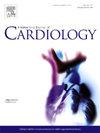Management of TAVR in asymptomatic or minimally symptomatic patients: Insights from resting angiographic microvascular resistance
IF 3.2
2区 医学
Q2 CARDIAC & CARDIOVASCULAR SYSTEMS
引用次数: 0
Abstract
Background
The optimal timing of transcatheter aortic valve replacement (TAVR) for asymptomatic or minimally symptomatic patients with severe aortic stenosis (AS) remains controversial. Microvascular dysfunction and increased microcirculatory resistance have been linked to adverse outcomes in AS, suggesting that resting angiographic microvascular resistance (AMRr) may aid in identifying higher-risk patients.
Method
We conducted a retrospective study of 180 severe AS patients who underwent TAVR at Fuwai Hospital between 2012 and 2021. Patients were grouped based on an AMRr cutoff value of 490, identified through receiver operating characteristic (ROC) analysis. The primary endpoint was the incidence of major adverse cardiovascular events (MACE), including all-cause mortality, heart failure, and myocardial infarction. Kaplan-Meier and Cox regression analyses were used to compare outcomes between groups.
Results
A total of 180 asymptomatic or minimally symptomatic AS patients undergoing TAVR were enrolled. After a 40-month follow-up, the AMRr >490 group had a higher MACE risk, mainly driven by readmission for heart failure. Additionally, continuous analysis indicated that every 100-unit increase in AMRr was associated with an 18 %, 17 %, and 1.58-fold increased risk of MACE, all-cause mortality, and NOAF, respectively. Moreover, the addition of AMRr to a clinical model significantly improved the prediction of MACE (AUC 0.678 vs. 0.582, p = 0.023).
Conclusion
Asymptomatic or minimally symptomatic AS patients with AMRr >490 had a significantly higher incidence of MACE and heart failure rehospitalization than those with AMRr ≤490 after TAVR. The inclusion of AMRr in a predictive model improved the accuracy for long-term MACE, demonstrating an incremental prognostic value.
无症状或轻微症状患者TAVR的处理:静息血管造影微血管阻力的见解
背景:对于无症状或症状轻微的严重主动脉瓣狭窄患者,经导管主动脉瓣置换术(TAVR)的最佳时机仍然存在争议。微血管功能障碍和微循环阻力增加与AS的不良结局有关,提示静息血管造影微血管阻力(AMRr)可能有助于识别高风险患者。方法对2012年至2021年阜外医院180例接受TAVR治疗的重症AS患者进行回顾性研究。通过受试者工作特征(ROC)分析,根据AMRr截断值490对患者进行分组。主要终点是主要不良心血管事件(MACE)的发生率,包括全因死亡率、心力衰竭和心肌梗死。Kaplan-Meier和Cox回归分析用于组间结果的比较。结果共纳入180例行TAVR的无症状或轻度症状AS患者。经过40个月的随访,AMRr >;490组的MACE风险更高,主要是由于心力衰竭再入院所致。此外,连续分析表明,AMRr每增加100个单位,MACE、全因死亡率和NOAF的风险分别增加18%、17%和1.58倍。此外,在临床模型中加入AMRr可显著提高MACE的预测(AUC为0.678比0.582,p = 0.023)。结论AMRr≤490的无症状或轻度症状AS患者TAVR术后MACE和心力衰竭再住院发生率明显高于AMRr≤490的患者。将AMRr纳入预测模型可提高长期MACE的准确性,显示出增加的预后价值。
本文章由计算机程序翻译,如有差异,请以英文原文为准。
求助全文
约1分钟内获得全文
求助全文
来源期刊

International journal of cardiology
医学-心血管系统
CiteScore
6.80
自引率
5.70%
发文量
758
审稿时长
44 days
期刊介绍:
The International Journal of Cardiology is devoted to cardiology in the broadest sense. Both basic research and clinical papers can be submitted. The journal serves the interest of both practicing clinicians and researchers.
In addition to original papers, we are launching a range of new manuscript types, including Consensus and Position Papers, Systematic Reviews, Meta-analyses, and Short communications. Case reports are no longer acceptable. Controversial techniques, issues on health policy and social medicine are discussed and serve as useful tools for encouraging debate.
 求助内容:
求助内容: 应助结果提醒方式:
应助结果提醒方式:


